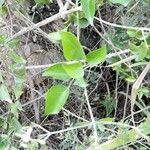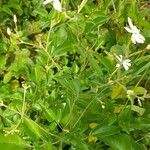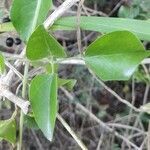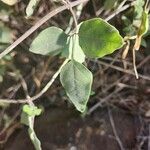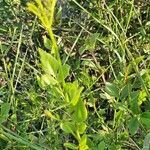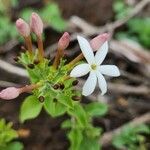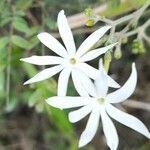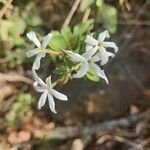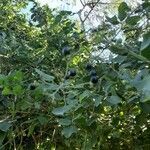Scandent shrubs to 3 m tall; branches solid, slender, terete, puberulent to tomentose with curled, simple hairs. Leaves opposite, trifoliolate, to 9 cm long; leaflets ovate, apically acuminate, acute or obtuse, basally subcordate, truncate, or short acuminate, the veins ca. 5 on each side, arcuate, not anastomosing at the margins, above pubescent on and near the midvein, otherwise glabrate, beneath glabrate except for tufts of tomentum in the axils of the lower veins; petiolules and petioles tomentose, the terminal petiolule and petiole about equal, 15-20 mm long, angled, the later petiolules shorter, 4-10 mm long. Inflorescences more or less open terminal panicles 4-15 cm long with several flowers opening at a time; petioles mostly 2-3 cm long, puberulent to tomentose, subtended by pairs of short, linear bracts ca. 3 mm long; pedicels 2-4 mm long, subtended by short, linear, tomentose bracts and often with 1 or 2 minute bractlets on the lower half. Flowers fragrant, heterostylous; calyx 2-3 mm long, cupular, as broad as long, glabrate to tomentose, the short teeth 1 mm long; corolla white, drying yellowish, salverform, the tube 15-30 mm long, slightly expanded apically, the lobes nar-row, 10-15 mm long; style branches fusiform, ca. 5 mm long, slightly exserted, the ovary subtruncate, slightly sulcate. Fruits pairs of ellipsoid, divaricate, bac-cate drupelets ca. 7 mm across; pyrenes not seen.
Generally a climbing or scrambling shrub with the young branches, and the calyces puberulous or tomentose to nearly or quite glabrous.. Leaves trifoliolate, opposite; leaflet blades ovate, broadly ovate, to nearly rounded or (rarely) slightly oblate, variable in size but usually about 2–5 cm. long and 1.5–3.5 cm. broad (up to 7 cm. long and 6 cm. broad), midrib slightly impressed on upper and with the lateral veins prominent on lower surface; petiolule to terminal leaflet 0.6–2 cm. long, to lateral leaflets 0.3–1 cm. long.. Inflorescences terminal and lateral, the final cymes having 3 to about 120 flowers, the lower numbers on the lateral and the higher on the terminal ones.. Calyx (at anthesis) 1.5–3 mm. long and 1.5–2 mm. in diameter at the apex which is sometimes more or less truncate but often extended into well-developed lobes.. Corollas scented, white or with the tube yellowish; tube 1–2.5 cm. long.
A bushy shrub or a woody creeper. It has twining stems. It grows 6 m long. The leaves have 3 leaflets. They can have white hairs on both surfaces. The leaflets are oval and 1-6 cm long by 1-4 cm for the side leaflets and the end leaflet is 3-9 cm long by 2-4 cm wide. The flowers are in groups at the ends of the plant. The plant varies a lot.
Woody climber or scrambler. Leaves compound, 3-foliolate, leaflets under 50 mm long; acarodomatia, if present, in axils of lower veins only. Inflorescence of broad lax cymes, terminal and axillary only in upper leaves. Calyx small, under 2 mm long. Flowers white.
Young shoots, petioles and peduncles smooth and glabrous or more usually crispate–pilose or lanate, the indurnentum pale greenish–yellow; bark of older branches at first smooth and brown, later cracking to reveal yellow streaks.
Leaflets ovate, elliptic or suborbicular, the apex acuminate, rounded or rarely emarginate, almost always with apiculum, the base rounded or acute; terminal leaflet 2·7–9 x 1·3–5 cm., lateral leaflets 1·2–6 x 0·8–3·8 cm.
Stamens inserted near the top of corolla tube; filaments up to 2·5 mm. long; anthers 3·4 mm. long, reaching to base of corolla lobes or up to 1 anther length distant.
Corolla white, often tinged red on outer surface; tube 11–28 mm. long; lobes (5) 6–9, 7–5–11 x 2·5–4 mm., elliptic with rounded and minutely apiculate apex.
Acarodomatia present, usually only in axils of lower lateral nerves but occasionally occurring almost to leaflet apex.
Petiole 0·5–2·5 cm. long; petiolules of lateral leaflets 0·4–1·8 cm. long, of terminal leaflets 1·2–2 cm. long.
Calyx glabrous or pubescent, tube 1·5–2 (2·5) mm. long, with 5–6 minute triangular teeth 0·25–0·5 mm. long.
Flowers in terminal several– to many–flowered corymbs, strongly scented; pedicels up to 3 mm. long.
Climber with long flexuous twining stems, attaining 6 m.; nodes of main branches well spaced.
Leaves trifoliolate, glabrous or more usually whitish– or yellowish–pilose on both surfaces.
Flowers cream-coloured or white tinged with pink, fragrant
Fruit 1–2–lobed, lobes subglobose, 6–7 mm. long when dry.
Style either exserted from or 1/3–1/2 as long as tube.
A scandent shrub
Fruits black.
